The sport of American Football was born in the mid 1800’s after Americans grew hungry for something a little different from soccer, and rugby. A primitive game was born that consisted of taking your opponent’s territory and defending it from them with everything you have. Walter Camp, the father of American football, introduced two rule changes that opened the game up in the 1870s. The quarterback position, and the first down allowed the sport to tell a different type of story than any other sport in the world. A story filled with heroes like Joe Montana and miracle moments like John Elway’s “The Drive.” As technology evolved through the years, Americans were soon able to watch their favorite teams at home on television, and with the introduction of video games, they were able to take control of those teams to create miracle moments of their own.
Video games failed to capture the look, and more importantly the feel of football in the early days of home consoles. After the crash of 1983, the football genre instead reached new heights on the PC. Computer gamers were treated to innovative games such as Accolade’s Fourth And Inches, and Cinemaware’s TV Sports: Football. Electronic Arts pushed the envelope even further when it released John Madden Football for the Apple II in 1988. EA’s first Madden was an unprecedented simulation of the strategic side of the sport. In 1990, a talented team of developers named Park Place Productions adapted the game for the Sega Genesis 16-bit Home Arcade Entertainment System, and a new annual American tradition was born.
John Madden Football
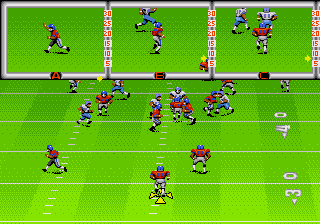 The first Genesis Madden is one of the most important releases in the early days of the console, and a game that pitched in to help prove that the “Genesis does what Nintendon’t.” This game just has an arcade feel like no other in the series, it even feels right to play it with an arcade joystick. How many other football games can you say that for? If you’re new to the sport, the first Genesis Madden (also released on the Mega Drive as John Madden’s American Football) is a great place to start. It’s a simple, easy to pick up and play American football game that doesn’t take itself too seriously. At the same time, it does a nice job of simulating the strategic side of the sport, definitely doing a better job than other football games of the era. Even though the 16-bit graphics, behind the quarterback view, and crisp voice clips were revolutionary for a home console football game in 1990, this one hasn’t aged all that well compared to some of its highly improved sequels.
The first Genesis Madden is one of the most important releases in the early days of the console, and a game that pitched in to help prove that the “Genesis does what Nintendon’t.” This game just has an arcade feel like no other in the series, it even feels right to play it with an arcade joystick. How many other football games can you say that for? If you’re new to the sport, the first Genesis Madden (also released on the Mega Drive as John Madden’s American Football) is a great place to start. It’s a simple, easy to pick up and play American football game that doesn’t take itself too seriously. At the same time, it does a nice job of simulating the strategic side of the sport, definitely doing a better job than other football games of the era. Even though the 16-bit graphics, behind the quarterback view, and crisp voice clips were revolutionary for a home console football game in 1990, this one hasn’t aged all that well compared to some of its highly improved sequels.
John Madden Football ’92
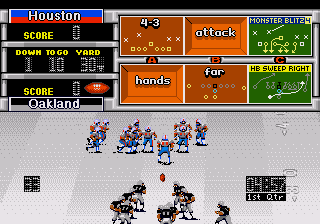 As far as the gameplay goes, Madden ’92 is easily the peak of the entire franchise. It’s all here: perfect controls, the same arcade feel as the first one, only with tighter, faster gameplay; more teams, weather effects, numbered players (accurate with the legendary 1991 NFL rosters), quarterback substitutions, instant replays and injuries. For some extra fun, a quirky glitch that adds to the game’s charm occurs when a player gets injured. An unmanned ambulance drives out on the field to pick up the fallen player, plowing all of the other players out of its way like a scene from the Stephen King movie Maximum Overdrive. Madden ’92 was exclusive to the Genesis, and fixed almost everything that was wrong with the first game.
As far as the gameplay goes, Madden ’92 is easily the peak of the entire franchise. It’s all here: perfect controls, the same arcade feel as the first one, only with tighter, faster gameplay; more teams, weather effects, numbered players (accurate with the legendary 1991 NFL rosters), quarterback substitutions, instant replays and injuries. For some extra fun, a quirky glitch that adds to the game’s charm occurs when a player gets injured. An unmanned ambulance drives out on the field to pick up the fallen player, plowing all of the other players out of its way like a scene from the Stephen King movie Maximum Overdrive. Madden ’92 was exclusive to the Genesis, and fixed almost everything that was wrong with the first game.
John Madden Football ’93
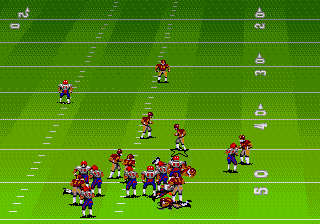 Madden ’93 seen the series bring in the trademark classic championship teams, the coin toss ceremony, stat tracking, and a battery backup for saving the tournament (exclusive to the Genesis port). Even though the arcade element was scaled back a tiny bit, Madden ’93 still maintained the same graphics, and gameplay engine as Madden ’92. All this came with little sacrifice, and the tight controls, addictive physics, and collision detection remained intact. There were even a few nice little animations added. A John Madden Football ’93 Championship Edition was released via rental store/mail order only and replaced the 1992 rosters with all of the Super Bowl teams from 1966 to 1991.
Madden ’93 seen the series bring in the trademark classic championship teams, the coin toss ceremony, stat tracking, and a battery backup for saving the tournament (exclusive to the Genesis port). Even though the arcade element was scaled back a tiny bit, Madden ’93 still maintained the same graphics, and gameplay engine as Madden ’92. All this came with little sacrifice, and the tight controls, addictive physics, and collision detection remained intact. There were even a few nice little animations added. A John Madden Football ’93 Championship Edition was released via rental store/mail order only and replaced the 1992 rosters with all of the Super Bowl teams from 1966 to 1991.
Madden NFL ’94
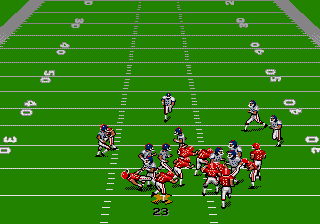 The 1994 installment was when William Robinson and his High Score Entertainment team took over development of the series. High Score kept a similar hand drawn style of graphics and arcade gameplay as the first three Genesis games with Madden ’94. It was also the first game in the series with a season mode and the NFL license allowing the use of actual NFL team names, and logos. Even though everything looks bigger, and the player animations are smooth, and seemless, Madden ’94 isn’t as well programmed as ‘92/’93. The bigger player sprites cause a bit of slowdown and flicker at times. Some of the team colors are missing, and the stat tracking from ’93 was dumped, which would have been nice with the new season mode. The Genesis port of Madden ’94 is held in high regards due to the addition of NFL team logos, and the season mode, while at the same time it was the final game in the series to retain the exaggerated, simple, arcade style of gameplay and control.
The 1994 installment was when William Robinson and his High Score Entertainment team took over development of the series. High Score kept a similar hand drawn style of graphics and arcade gameplay as the first three Genesis games with Madden ’94. It was also the first game in the series with a season mode and the NFL license allowing the use of actual NFL team names, and logos. Even though everything looks bigger, and the player animations are smooth, and seemless, Madden ’94 isn’t as well programmed as ‘92/’93. The bigger player sprites cause a bit of slowdown and flicker at times. Some of the team colors are missing, and the stat tracking from ’93 was dumped, which would have been nice with the new season mode. The Genesis port of Madden ’94 is held in high regards due to the addition of NFL team logos, and the season mode, while at the same time it was the final game in the series to retain the exaggerated, simple, arcade style of gameplay and control.
Madden NFL ’95
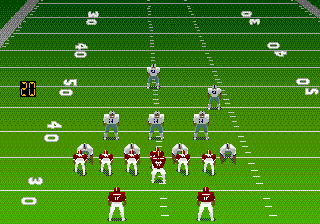 High Score’s second Genesis effort was a turning point in the series. William Robinson’s crew stripped away the Park Place arcade spirit of the game when they completely redesigned Madden NFL ’95 from the ground up. Madden ’95 brought improvements to the single-player gameplay with the smartest AI in the series up to that point, as well as stat tracking in the season mode and a much needed upgrade to the playbooks. ’95 was the year that the series started to evolve away from an arcade feel and into a simulation of what we watch on TV. Even though they cleaned up the graphics with digitally rendered sprites, more accurate team colors, and a better looking field, the gameplay took a major hit. The passing game was improved with the removal of the passing windows, but the arcade physics were scaled back quite a bit, and it just feels a little stiff. Gone were the 15-yard dives to sack the quarterback or block a punt. Gone were the 90-yard touchdown bombs and the 20 broken tackles via the spin move. The collision detection feels a little off, and the controls are unresponsive and sticky at times. The Genesis port of Madden ’95 was the only version of the game to feature the NFLPA license, allowing the use of actual player names in the game for the first time in the series.
High Score’s second Genesis effort was a turning point in the series. William Robinson’s crew stripped away the Park Place arcade spirit of the game when they completely redesigned Madden NFL ’95 from the ground up. Madden ’95 brought improvements to the single-player gameplay with the smartest AI in the series up to that point, as well as stat tracking in the season mode and a much needed upgrade to the playbooks. ’95 was the year that the series started to evolve away from an arcade feel and into a simulation of what we watch on TV. Even though they cleaned up the graphics with digitally rendered sprites, more accurate team colors, and a better looking field, the gameplay took a major hit. The passing game was improved with the removal of the passing windows, but the arcade physics were scaled back quite a bit, and it just feels a little stiff. Gone were the 15-yard dives to sack the quarterback or block a punt. Gone were the 90-yard touchdown bombs and the 20 broken tackles via the spin move. The collision detection feels a little off, and the controls are unresponsive and sticky at times. The Genesis port of Madden ’95 was the only version of the game to feature the NFLPA license, allowing the use of actual player names in the game for the first time in the series.
Madden NFL ’96
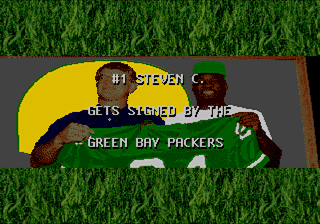 EA went all out with The ’96 edition of Madden. Tommy Tallarico was brought in to take care of the game’s music and sound, and a lot of attention was paid to the fine details in the game’s graphics. ‘96 still uses the previous year’s engine, but a lot of improvements were made, such as faster gameplay, sharper colors, several new, and improved animations, numbered uniforms, realistically textured fields, team logos in the end zones, and a slick, classy, modern interface. ’96 is also one of the fastest moving football games of the 16-bit era, possibly even a bit too fast at times. Tommy Tallarico did some nice work with the games music and sound effects and did an exceptional job of integrating sampled sounds and music into synthesized FM chip tunes throughout Madden ‘96. The highlight of the game’s music is the various touchdown “stingers” that play when you score a touchdown and the long, crystal clear PCM sample of the NFL on Fox theme song in the intro of the game, a nice little showcase of what the Genesis audio hardware is capable of. Madden ’96 also brought back the classic championship teams, which are unlocked in the team select screen via a seven button combination code (BCCCBBA unlocks the ’85 Bears, for example). Madden ’96 was also the first year that you could modify the team rosters with trades and free agent signings. Additionally, there was a “scouting combine” mode, where you created a player and played through a series of mini games to determine his skill level. Even though ’96 was a big improvement over ’95, it still lacked the easily accessible gameplay of earlier releases and continued to carry the series closer to a true simulation. ’96 was a big budget sports title for the Genesis that every football fan had to have back in 1995, a time when the Genesis was the premier console for American football video games.
EA went all out with The ’96 edition of Madden. Tommy Tallarico was brought in to take care of the game’s music and sound, and a lot of attention was paid to the fine details in the game’s graphics. ‘96 still uses the previous year’s engine, but a lot of improvements were made, such as faster gameplay, sharper colors, several new, and improved animations, numbered uniforms, realistically textured fields, team logos in the end zones, and a slick, classy, modern interface. ’96 is also one of the fastest moving football games of the 16-bit era, possibly even a bit too fast at times. Tommy Tallarico did some nice work with the games music and sound effects and did an exceptional job of integrating sampled sounds and music into synthesized FM chip tunes throughout Madden ‘96. The highlight of the game’s music is the various touchdown “stingers” that play when you score a touchdown and the long, crystal clear PCM sample of the NFL on Fox theme song in the intro of the game, a nice little showcase of what the Genesis audio hardware is capable of. Madden ’96 also brought back the classic championship teams, which are unlocked in the team select screen via a seven button combination code (BCCCBBA unlocks the ’85 Bears, for example). Madden ’96 was also the first year that you could modify the team rosters with trades and free agent signings. Additionally, there was a “scouting combine” mode, where you created a player and played through a series of mini games to determine his skill level. Even though ’96 was a big improvement over ’95, it still lacked the easily accessible gameplay of earlier releases and continued to carry the series closer to a true simulation. ’96 was a big budget sports title for the Genesis that every football fan had to have back in 1995, a time when the Genesis was the premier console for American football video games.
Madden NFL ’97
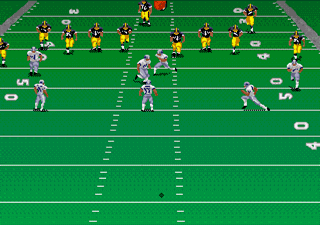 At first glance, Madden ’97 appears to be a step back from ’96 on the Genesis. As far as the graphics, sound, and presentation, it really is, but the gameplay was beefed up quite a bit. The 1997 game was the first year that the Madden series made it to the 32-bit consoles, and the 16-bit ports of the game were developed to look and play as close to those versions as possible. The developers actually did a nice job with the physics and animations of the game to give it the same feel as its 32-bit big brother. Compared to the Genesis port of ‘96, ’97 plays much slower, and the graphics just don’t look as smooth and colorful. The music and sound is also a big step back, both in terms of sound quality and composition. In fact, the 16-bit version of ’97 seems like it was developed with the SNES in mind and ported over to the Genesis as an afterthought, as both games are nearly identical. One of the only differences though, is that the Genesis version still only uses three buttons. Full use of the six-button controller would have been a welcomed improvement by ’97.
At first glance, Madden ’97 appears to be a step back from ’96 on the Genesis. As far as the graphics, sound, and presentation, it really is, but the gameplay was beefed up quite a bit. The 1997 game was the first year that the Madden series made it to the 32-bit consoles, and the 16-bit ports of the game were developed to look and play as close to those versions as possible. The developers actually did a nice job with the physics and animations of the game to give it the same feel as its 32-bit big brother. Compared to the Genesis port of ‘96, ’97 plays much slower, and the graphics just don’t look as smooth and colorful. The music and sound is also a big step back, both in terms of sound quality and composition. In fact, the 16-bit version of ’97 seems like it was developed with the SNES in mind and ported over to the Genesis as an afterthought, as both games are nearly identical. One of the only differences though, is that the Genesis version still only uses three buttons. Full use of the six-button controller would have been a welcomed improvement by ’97.
Once you get past the lazy graphics and sound and start digging through the game’s features, you’ll find that EA packed ’97 with as much game as its cartridge could hold. The playbooks were finally beefed up. The roster editing was improved, and you get a lot more freedom with the trades than in ’96. All of the championship teams from ’96 are available from the start of the game, and there is even a custom tournament mode in which you can use them. You can also save instant replays to the cartridge, create players, save records, and adjust difficulty and penalty levels. The best new feature to the gameplay is the “any player” mode, which you can turn on in the options screen. Any player mode allows you to play as an offensive lineman, running back, or receiver on offense. The computer AI in Madden ’97 is the smartest of any 16-bit football game, which makes it a legitimate challenge to players. ’95 and ’96 seemed to be challenging in a cheap way, but ’97 seems to outsmart you at times with the play calling and clock management. Even though it seems uninspired compared to ’96, ’97 did improve the gameplay over the previous engines. The collision detection, physics,and controls kind of feel like the older games, but with much more of a challenge, and much less of the arcade style.
Madden NFL ’98
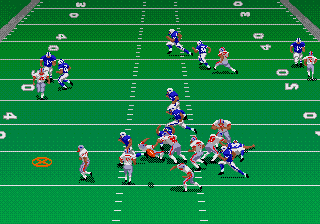 Madden ’98 is merely a roster and team color update for Madden ’97. Other than that and an improved interface, the only other thing that changed was the addition of a few meaningless gameplay options. In the main menu, ’98 gives you the option to jump straight into one of the past Super Bowls (as far back as 1988), but some of the classic championship teams have messed up roster numbers (’94 Redskins?). They also cut out the custom tournament option for some reason. Some other options that you get are a third difficulty setting and the ability to play a game with two minute-long quarters, which is nice for a quick game. Aside from those minor changes, a 1997 NFL roster update, and the new uniform colors/logos for the Denver Broncos and Tampa Bay Buccaneers, ’98 is pretty much the same game as ’97. The players look the same, the field looks the same, and all of ’97’s features, like any player mode, save a replay, create a player etc., are identical to Madden ’97. Not only does it look the same, it also plays the same as well, which is a good thing. Madden ’98 has the same solid gameplay engine as Madden ’97, which is one of the best of the 16-bit era. Even though it is a solid 16-bit football title on its own, Madden ’98 failed to make any improvements over ’97 and failed to take full advantage of the Genesis hardware’s capabilities.
Madden ’98 is merely a roster and team color update for Madden ’97. Other than that and an improved interface, the only other thing that changed was the addition of a few meaningless gameplay options. In the main menu, ’98 gives you the option to jump straight into one of the past Super Bowls (as far back as 1988), but some of the classic championship teams have messed up roster numbers (’94 Redskins?). They also cut out the custom tournament option for some reason. Some other options that you get are a third difficulty setting and the ability to play a game with two minute-long quarters, which is nice for a quick game. Aside from those minor changes, a 1997 NFL roster update, and the new uniform colors/logos for the Denver Broncos and Tampa Bay Buccaneers, ’98 is pretty much the same game as ’97. The players look the same, the field looks the same, and all of ’97’s features, like any player mode, save a replay, create a player etc., are identical to Madden ’97. Not only does it look the same, it also plays the same as well, which is a good thing. Madden ’98 has the same solid gameplay engine as Madden ’97, which is one of the best of the 16-bit era. Even though it is a solid 16-bit football title on its own, Madden ’98 failed to make any improvements over ’97 and failed to take full advantage of the Genesis hardware’s capabilities.
King of the Hill (By Default)
EA’s Madden series had a lot of good competition on the Genesis throughout the years, and gamers had a lot of choices when it came to football games on the Genesis. Developers knew that and were forced to raise the bar for their products with each annual release. EA released its twenty-fourth game in the series with Madden NFL ’12 in August of 2011, which again topped the software sales charts unchallenged and unchanged from Madden NFL ’11. After the 2005 game, EA secured an exclusive license with the NFL, effectively eliminating any and all competition in the market, including Sega’s innovative NFL 2K series. Of all the 26 different video game devices on which the series has appeared, John Madden Football’s eight-year run on the Sega Genesis will forever be the heart of the franchise.

I never realized that the John Madden Championship Edition had a mail order release also. I guess because it says ‘Rental Store Exclusive’ on the cart. I wrote a bit about that title here: http://wp.me/p1R3IO-3G
Great retrospective you put together here.